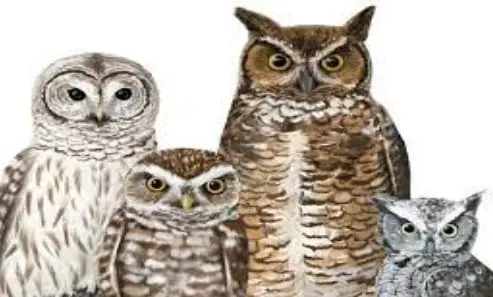Last Updated on: February 3, 2025
Home to more than 630 bird species, Texas is one of the hottest spots for birding enthusiasts in the United States. With its ideal geographic location, it attracts all kinds of birds, including owls.
While they are easy to recognize with their large and forward-facing eyes, the identification of owls in Texas can be baffling.
No more confusion now!
Read on and I will share some of the most common owls in the state, including their physical characteristics and behaviors.
The Most Popular Owls In Texas
From public parks to private backyards, owls are everywhere in The Lone Star State. Some are roaming freely and are easy to spot while others require hours of hiking for a personal encounter.
If you are new to birding, you might think that all Texas owl species look the same. However, as you look closer, you will realize that they are different in more ways than one.
So, how do you identify which is which?
Here is a quick rundown of the various species in the state for easy Texas owl identification.
1. Great Horned Owl
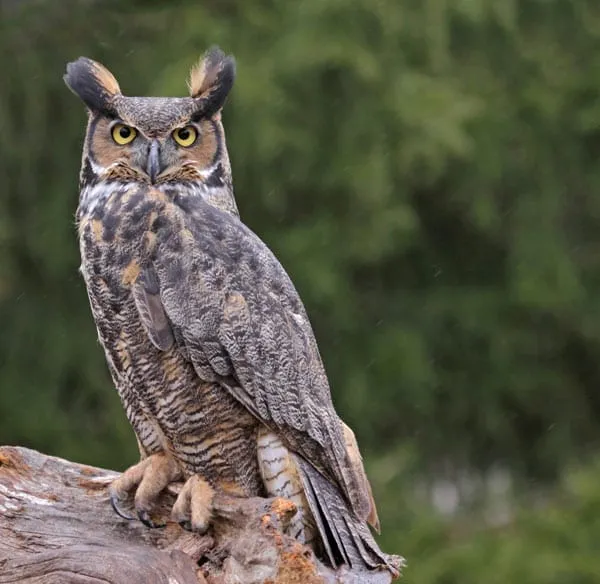
With a length of up to two feet, this is the largest owl in Texas. It is also the most common raptor you will find in North America. The name comes from two large feather tufts that crown its head, which look like great horns. Its habitats include suburbs, deciduous woods, swamps, coniferous forests, and orchards.
A night hunter, the great horned owl is a perch and pounce hunter.
Its preys include rats, skunks, squirrels, rabbits, and gophers. They will go for almost anything their size or smaller.
These owls in Houston are most vocal in the fall and winter. Their slow and deep Texas owl sounds are soft and can be easy to miss if you are not listening closely.
2. Barn Owl
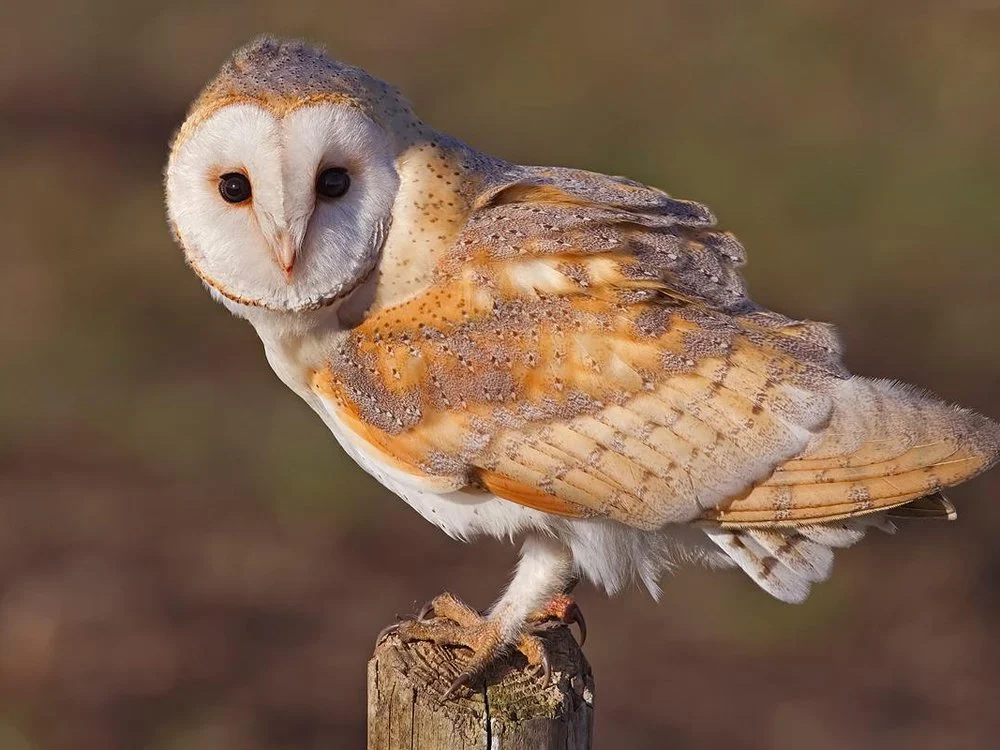
If you are looking for picturesque Texas owls species, it is hard to go wrong with the barn owl. Its wide black eyes perfectly complement the heart-shaped and pale face.
They look even more beautiful and graceful when they are flying. The mottled feathers and golden back are sure to be a sight to behold for any birding enthusiast.
A strictly nocturnal bird, you will find them in Texas throughout the year.
In private residences, they are commonly found in chimneys. In the wild, they reside in woodlands where there is a wide canopy cover.
The Barn owl, being one of the owls that’s native to Texas, is easy to spot! One good place to see them in public is at the Big Bend National Park. You will find them mostly in Northwest Houston and Greater Corpus Christi area. They are also common in Dallas, although their sightings are sporadic.
3. Eastern Screech Owl
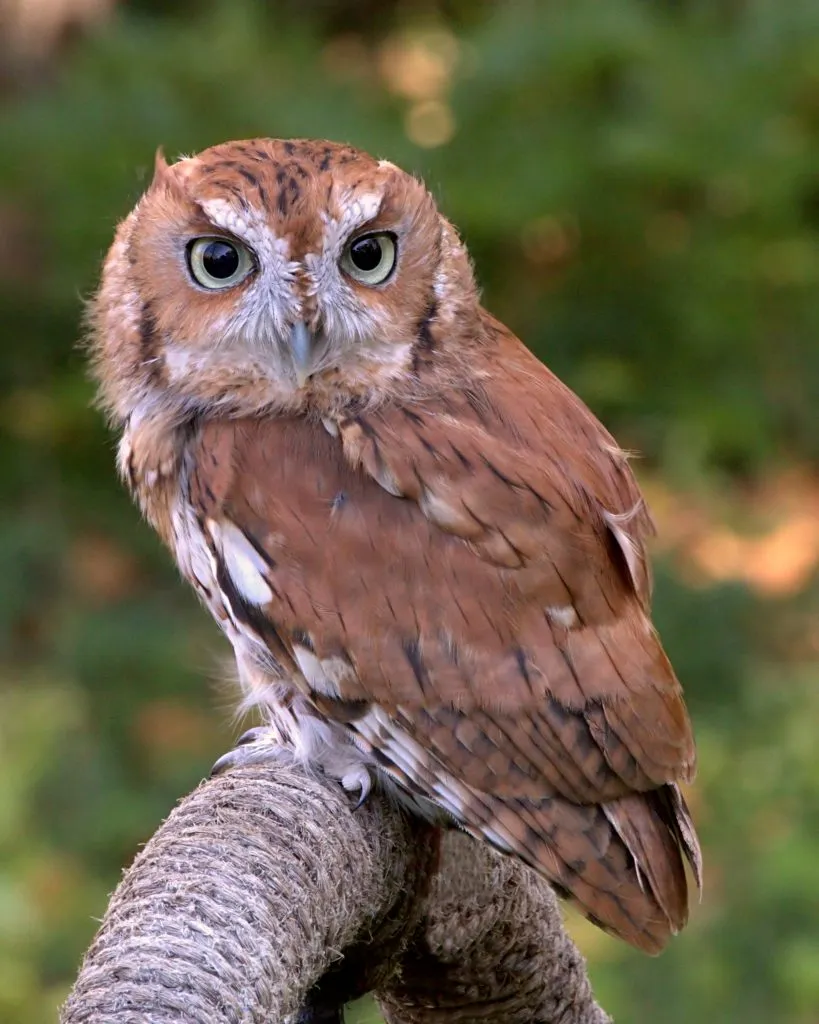
At an average length of six to eight inches, these small owls in Texas are tricky to find. Most people will think of them as baby owls because of their size, even if they are already adults. When the eastern screech owl roams at night, its most common targets include small mammals and reptiles.
They are fast and can even nab a fish in the water!
While such owls in Central Texas are most usual in forests and woodlands, you can also attract them in your backyard. Add a nest box in your garden and they will soon visit you.
4. Western Screech Owl

It is almost similar to the eastern screech owl in terms of size and appearance. The biggest difference is their location. Western screech owls are more common on the western side, including Trans-Pecos and Stockton.
Cute and stocky, the Western screech owl has expressive eyes that will beguile any birdwatcher.
Despite its name, a western screech owl is not screechy. Its sounds are characterized by a sudden speeding at the end while maintaining a constant pitch throughout.
Adults are extremely territorial. These owl species in Texas will protect their nests even from larger birds, including crows.
5. Barred Owl

Like barn owls, barred owls have heart-shaped, pale faces adorned with large eyes. The head, meanwhile, is smooth and tuftless. Its eyes are solid black and have no visible pupils.
It is known for being cautious and observant.
From afar, these owls in San Antonio might be watching you! Approach with caution if you want an up-close encounter.
One of the most popular East Texas owls, they reside in deciduous and mature forests. They often compete with spotted owls for habitats. At a length of 18 to 25 inches, these large owls in Texas are at the top of the food chain. A typical feast includes squirrels, bats, rabbits, rats, frogs, turtles, snakes, and even other birds.
6. Burrowing Owl

One of the most familiar owls in Austin, a burrowing owl does not spend most of its time in trees. Instead, it burrows underground.
The burrowing owl has a unique habit of attracting prey. They spread the waste of other animals to the entrance of their homes. When the animals collect the poop, that is when the owl catches its prey. Isn’t that smart?
Unlike other Texas owls sounds, their cuckoos are not too vocal. Most of the time, it is two syllables, such as who-who. Males are louder, especially when mating or defending their nest.
7. Spotted Owl

As the name implies, spotted owls have brown and white spots on the back, head, and abdomen. It has all-black eyes while the body is chestnut brown.
Unlike most owls in West Texas, it is a bird of concern because of its declining population. Habitat destruction and disturbance made them hard to find nowadays.
Elevated and cool locations are their preferred habitats, mostly at an elevation of up to 7,000 feet. They love Douglas fir and white pine as their nesting sites. Aside from its appearance, another easy way to identify this owl in Texas is to listen to its call — it has a soft four-note hoot.
8. Flammulated Owl
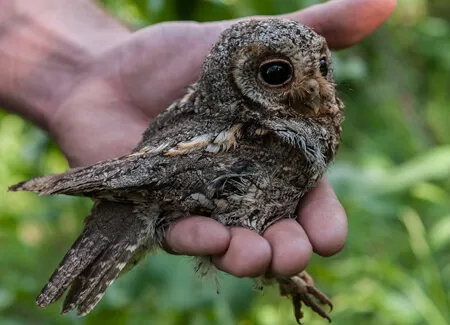
It is a tiny and reddish bird that is barely bigger than a can of juice. It has an average length of six inches and a wingspan of 14 inches.
An inhabitant of mountainous pine forests, the flammulated owl is amongst the most popular owls in North Texas. Because of its small size, this owl species in Texas is hard to spot during the daytime thanks to its natural camouflage! This owl is most common in the western part of the state.
9. Snowy Owl
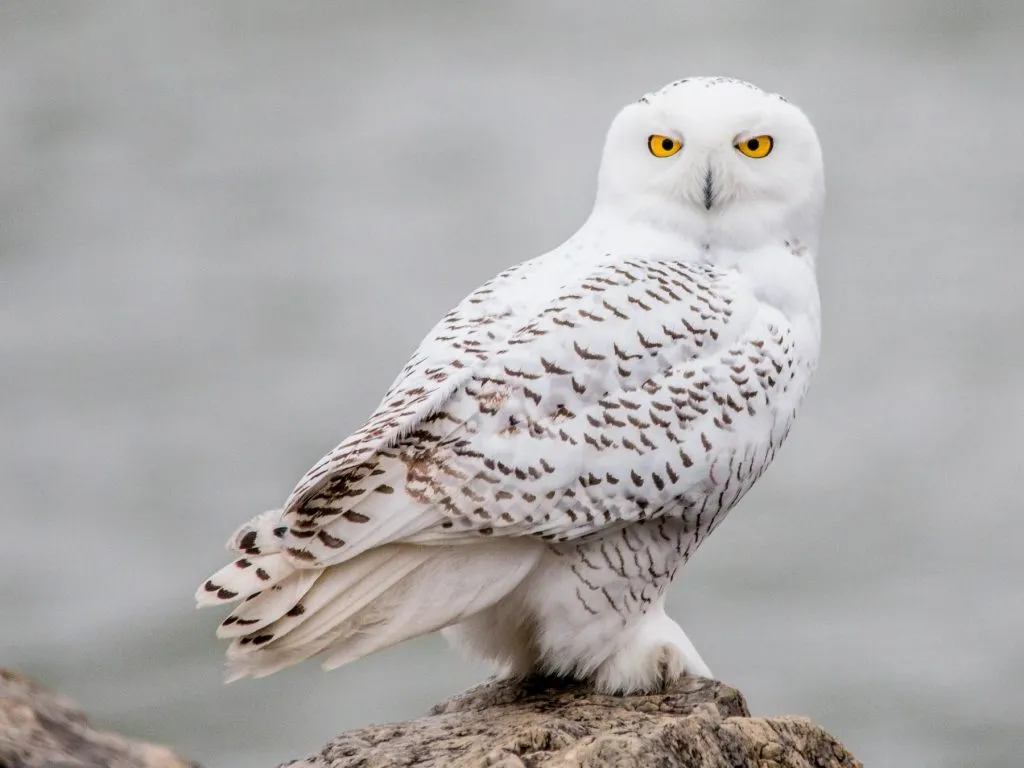
White owls in Texas are a rare sight! So, if you see a snowy owl, consider yourself lucky!
Large and powerful, a snowy owl has a length of 20 to 28 inches and a wingspan of up to five feet.
The Snowy owl species of Texas are more common in an Arctic tundra where they inhabit open and treeless areas. Some years, they can find their way to Texas through irruption, a natural phenomenon where the birds migrate to the south.
It has already been years since a snowy owl was seen in Texas. It was in 2018 when birdwatchers in the state have seen it in Fort Worth.
10. Northern Pygmy-Owl

One of the least common owls in Texas, the northern pygmy has a height of 6.3 to 7.1 inches, wingspan of 15 inches, and weight of 62 to 72 grams. Despite being a small owl, it is a ferocious hunter. It hunts even larger mammals and birds.
Nonetheless, they are also the prey of larger birds. With this, they commonly hunt during the day, unlike other owls in the state that are more active during the night.
To date, only five Northern pygmy owls were spotted in Texas, making them among the rarest in the state.
11. Long-Eared Owl
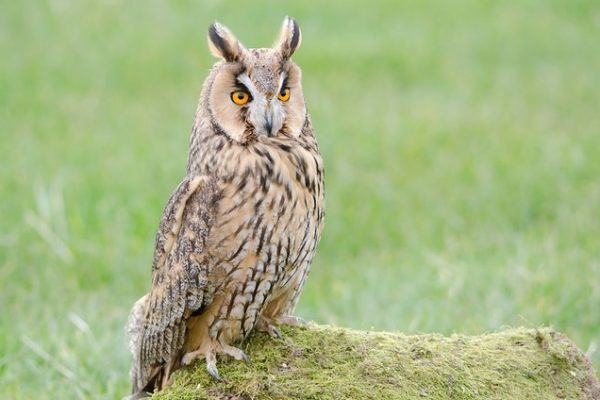
The defining characteristic of these South Texas owls is their long ear tufts. It looks like a great horned owl but smaller. It is one of the rarest owls in the state. According to the Wildlife Center of Texas, they have only cared for two to three of them in almost two decades.
The long eared owl is now classified as at risk, and to an extent, endangered.
The decline in their population is a result of habitat destruction. While their infrequent sightings are scattered throughout the state, the highest concentration is in Texas Panhandle, especially in open grasslands.
12. Short-Eared Owl
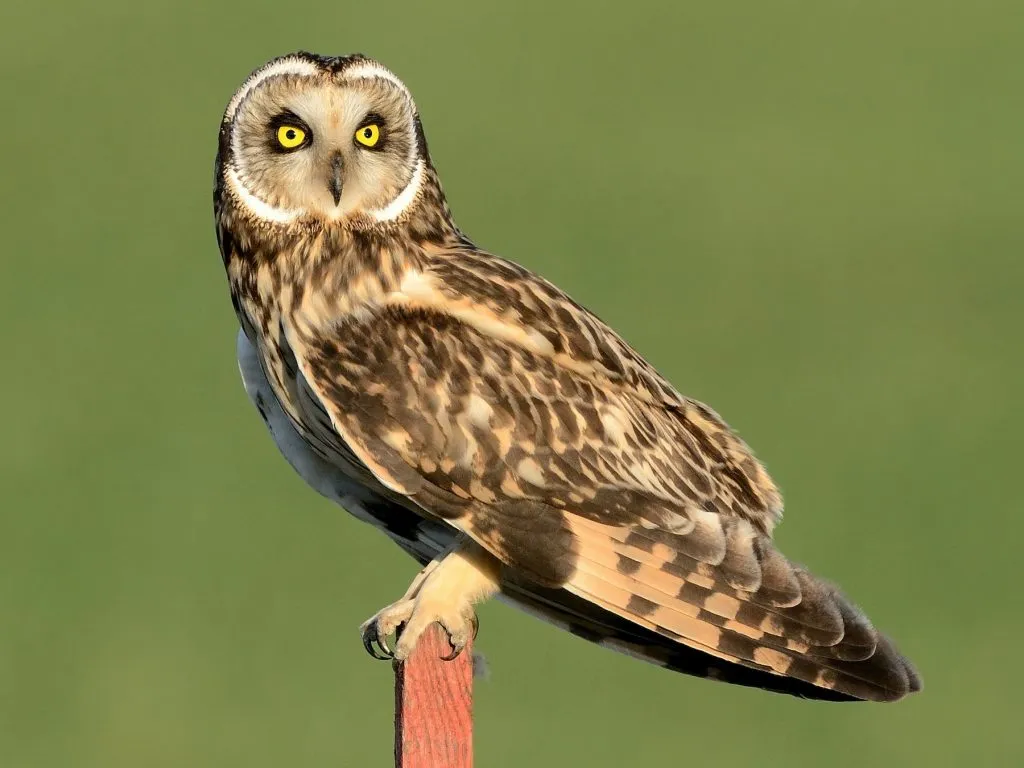
The short-eared owls are more common-sight compared to their long-eared counterparts. Despite this, they are not as rampant as other species.
Being crepuscular, short-eared owls, they are most active at dawn and dusk.
They are low flying and often seen coursing back and forth to hunt for their prey in open grasslands. You will find these owls in Texas only in the winter and they hate urban areas. They prefer wandering around undeveloped and open places without too many trees, instead.
Feeling lucky? Some of the best places to check them out are Granger Lake, Katie Prairie Conservancy, and Attwater Prairie Chicken National Wildlife Refuge.
13. Ferruginous Pygmy-Owl
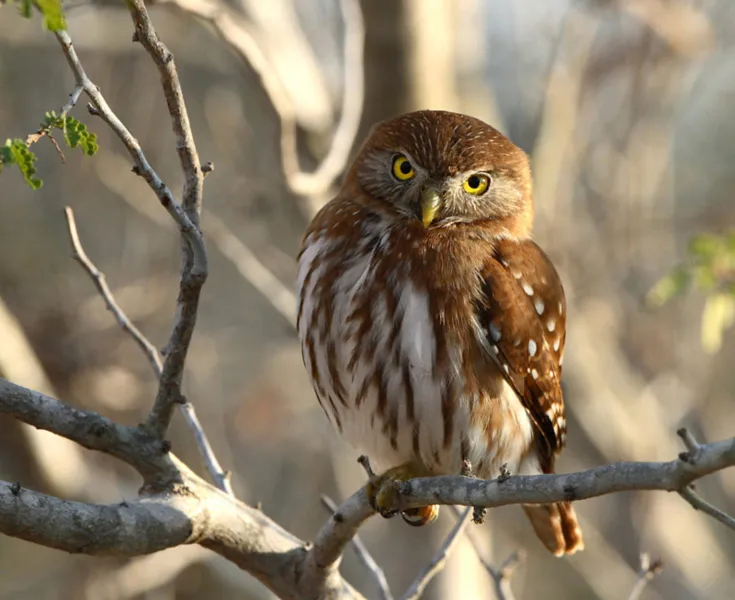
A small owl that loves the American tropics, its status in Texas is uncommon to rare. If you want to see them, then you must travel far south.
Its diet includes large insects and small mammals, and the owl’s favorite hunting time is at dusk and dawn. The ferruginous pygmy-owl often sits on a perch, watches its prey, and flies quickly to capture its food.
If there is one place that you should check out, it would be King Ranch, specifically the Norias Division. The latter has the highest concentration of ferruginous pygmy owls in the country. Book one of their day-long tours and see this owl up close!
14. Elf Owl

It is the world’s smallest owl, making it an interesting subject for birdwatching.
In terms of habitat, they thrive in deserts and dry scrubs. They are common in the western and southern parts of the state, especially in places with lots of oaks and sycamores.
If you want to see them, you must wait until the evening. As it goes dark, they magically go out of their habitats and poke their heads outside tree cavities. They will start to vocalize as they roam.
15. Mottled Owl

Technically, this is the rarest amongst the species in Texas.
It was not spotted flying or hunting in the state but found dead instead on the side of the road. The year was 1983 when a man found a dead owl before entering the Bentsen Rio Grande State Park.
After a three-year investigation, researchers confirmed that it was the first sighting of the mottled owl in the state. Since then, there had been no other recorded sightings of them. Even if you go online and search for Texas owls pictures, you might probably come up with zero results!
Watch This!
Frequently Asked Questions
Is it legal to kill owls in Texas?
It is illegal to kill Texas owls. State and federal laws protect owls, along with other non-game birds like hawks and eagles. You cannot kill them even if they are threatening livestock. Anyone caught violating the rules can face misdemeanor charges, among other consequences.
Which places in Texas can you find owls?
Some of the most popular places to find owls of Texas are in the state, national, and public parks. You can see owls at the Big Bend National Park, Davis Mountains, Rio Bosque Park, Rio Grande Valley, Granger Lake, and Kickapoo Caverns State Park.
Also, look for woodland edges, agricultural fields, and old neighborhoods with large trees to spot owls.
Can I keep an owl as a pet in Texas?
Yes, you can keep an owl as a pet in Texas. However, this is not for everyone. You will need to be a licensed falconer or rehabilitator. To acquire a license, you need to pass a series of tests and go through extensive training.
Conclusion
Are there owls in Texas?
Definitely!
You will find different species of Texas owls, each with varying appearance, behaviors, and habitats. From deep forests to private gardens, they are everywhere — hooting, feeling, and watching with enigma written all over them.
However, not all owls are crowd-pleasers! Many of them are shy, especially those that are nocturnal. You need to have patience and good temperance if you desire to see and enjoy them up close.

